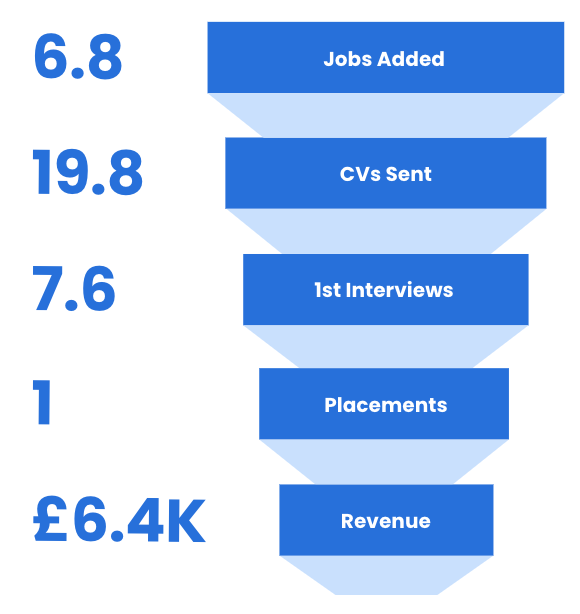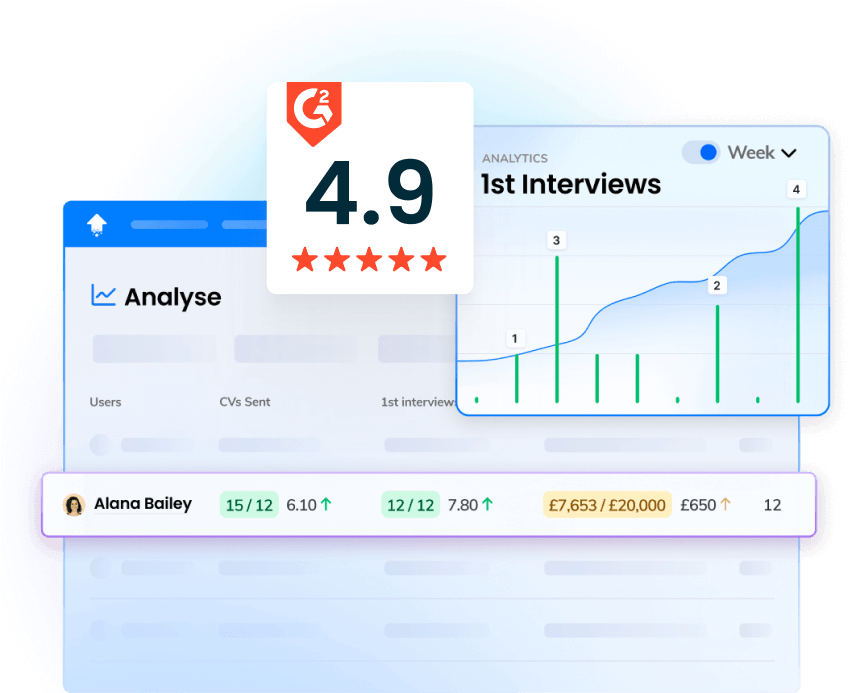In 2024, recruitment metrics are more crucial than ever.
These metrics reveal invaluable insights into your recruiters' performance and the overall effectiveness of your hiring process.
Once the domain of data scientists, now any recruiter can use recruitment metrics to find out what's working and what's not, and make data-driven decisions.
Recruitment metrics help you to create more accurate forecasts, streamline your process, refine your strategy, optimise costs, and get the best out of your team.
And with modern recruitment agencies harnessing metrics incredibly effectively, those who avoid data analytics will inevitably find themselves trailing behind the competition.
Ready to find out more?
Read on for a breakdown of 19 essential recruitment metrics your agency should track to achieve better outcomes.
What Are Recruitment Metrics?
Recruitment metrics are measurable data points that speak to the effectiveness of your hiring process.
Some of the most popular recruiter metrics include Time to Fill, Cost per Hire, and Quality of Hire.
These metrics offer quantifiable insights into different aspects of recruitment.
They can quickly reveal issues that arise within the hiring process, allowing you to resolve them before they escalate and answer key questions such as how a new recruiter is performing.
By tracking metrics, you can constantly hone and optimise your recruitment strategy in response to market changes, putting you firmly ahead of the crowd.
Why It's Important to Track Recruitment Metrics in Both Hiring Agencies and Internal Teams
Recruitment metrics empower you to make data-driven decisions.
The ability to do this is key in hiring agencies and internal teams. Whether competing with other recruitment agencies or businesses, you need to optimise your strategy.
After all, when the competition is making data-backed decisions, going off gut instinct alone isn't going to cut it.
By monitoring common recruiting metrics such as time-to-fill, you gain valuable insights into the effectiveness of your processes.
This makes it much easier to accurately identify areas for improvement, enhance the candidate experience, and demonstrate ROI.
Recruitment Performance Metrics to Track in 2024
As outlined above, modern recruiters can't afford to avoid data analysis.
Here are 19 of the best recruiting metrics to track in 2024.
#1 Source of Hire
The Source of Hire metric tells you which channel or platform a candidate was initially recruited from.
This could be LinkedIn or other social platforms, general job boards, niche job boards, employee referrals, employer career pages, or recruitment agencies.
So why is this useful for recruiters?
By tracking the origin of successful hires, you can determine which channels are most successful — and for which roles.
For example, say you're a marketing recruiter.
When you're looking for creative talents such as copywriters, videographers, or graphic designers, specialist job boards might lead to the most successful hires.
But when you're seeking marketing account managers, you find the most successful candidates on LinkedIn.
Once you have this data, you can eliminate inefficiencies.
Instead of spending hours searching for graphic designers on LinkedIn, you can go straight to your specialist job board. Meanwhile, you can optimise your account manager search for LinkedIn.
This way, you're making efficiency gains while getting better results.
Ultimately, tracking 'Source of Hire' tells you where to invest your team's time and resources in discovering top talent.
#2 Time to Fill
Time to Fill is a simple but essential recruitment metric to track.
To measure Time to Fill, simply count the days it takes to fill a job opening, starting on the day it was posted and ending when a job offer is accepted.
This metric provides crucial insights into the efficiency of the hiring process.
The big win here is enhanced efficiency.
When you're streamlining your processes, your Time to Fill is a good indicator of how effective your methods are.
If you change an element of the hiring process and Time to Fill falls, you can conclude that it was a productive adjustment to your strategy and should continue.
If, on the other hand, you notice your average Time to Fill rising, it's time to examine the data to determine exactly when in the hiring process the time sink is occurring.
Similarly, tracking Time to Fill empowers you to identify bottlenecks in the recruitment process that cause delays, enabling you to resolve issues more quickly.
You can also optimise your resource allocation by considering the average Time to Fill for different roles or agency clients.
Remember: shorter hiring times can significantly improve the candidate experience and reduce the risk of losing out on top talent to rivals.
#3 Time to Hire
Time to Hire vs Time to Fill — what's the difference?
As outlined above, you measure Time to Fill from the day the job is posted.
With Time to Hire, you count the days from when the eventual hire entered the candidate pipeline to when the job offer is accepted.
This first contact point may be when the successful candidate submits an application form, sends in their CV, or contacts your recruiters about the role.
This metric illustrates how quickly you moved your top candidate down the pipeline.
Time to Hire is a key metric for improving hiring outcomes and streamlining your overall recruitment process. It's also valuable when focusing on candidate experience.
It gives you the data you need to reduce waiting times during the candidate experience and keep top talent engaged.
This metric also evaluates the efficiency of your hiring process and improves planning and resource allocation by giving you an understanding of how long different roles take to fill.
Read more: How to Reduce Time to Hire
#4 Sourcing Channel Effectiveness
Sourcing Channel Effectiveness evaluates the performance of different sourcing channels in attracting and hiring qualified candidates.
Tracking this metric empowers you to drill down into the quality of candidates you discover from each channel.
Using this metric, you can also calculate the percentage of candidates from each channel who eventually become successful hires — your conversion rate.
#5 Sourcing Channel Cost
Different recruitment sourcing strategies have different costs associated with them.
These fees may comprise direct costs for recruitment agencies (if you're an internal recruiter), social media ads, or job boards.
But there are also indirect costs to consider — aka the time spent by recruiters managing the channel.
Of course, some of these costs are worth paying.
But if you've never dug into your sourcing channel metrics before, you're likely wasting budget on channels that are simply not generating ROI.
Tracking Sourcing Channel Cost is the first step.
When you cross-reference this metric with Sourcing Channel Effectiveness, you should be able to make data-backed decisions about which channels are worth the money and which can be cut.
#6 Applicants per Opening
Applicants per Opening measures the average number of candidates applying for each job opening.
You can calculate it as follows:
Total number of job applications from [date X] to [date Y] / Total number of job openings from [date X] to [date Y]
Why is Applicants per Opening worth tracking?
It evaluates your sourcing efficiency, assesses the effectiveness of your job ads, and indicates how attractive your job openings are to potential candidates.
#7 Application Completion Rate
This metric is a simple one.
Application Completion Rate measures the percentage of job seekers who complete the application process after starting it.
This gives recruiters a helpful insight into the candidate experience during the application process.
Drill down further into this data to find out when applicants are dropping out of the process, and consider how you could revise the application to up your Application Completion Rate.
#8 Selection Ratio
The Selection Ratio metric calculates the ratio of hired candidates to the total number of applicants.
Here's how to calculate your ratio:
Number of hires from [X date] to [Y date] / Total number of applicants [X date] to [Y date]
So, what does the selection ratio tell you?
It gives you an insight into the efficiency of the recruitment and selection process.
It also illustrates the attractiveness of the employer brand.
Do you have a low selection ratio?
This generally means you have a highly competitive selection process.
A high selection ratio typically implies a less selective hiring process.
#9 Candidate Experience
Developing a positive candidate experience is vital to the success of any recruitment agency.
Why?
A poor candidate experience can lead to:
- Drop-offs during the hiring process
- Losing out on top talent to other agencies or businesses
- Negative candidate feedback to your clients
- Delivering low-quality candidates to clients
- Low candidate engagement
- Bad reviews online
- Lower revenue
Measuring Candidate Experience is more complex than many of the other metrics, as it typically requires a variety of techniques.
These can include:
- Candidate surveys
- Interview feedback
- Measuring Time to Respond
- Application process analysis
- Gathering input from social media and review websites
- Tracking your Candidate Net Promoter Score
#10 Offer Acceptance Rate
The Offer Acceptance Rate tracks the percentage of job offers accepted by candidates.
It is calculated like so:
(Number of offers accepted / number of offers made) x 100
By tracking the Offer Acceptance Rate, you can evaluate the attractiveness of your job offers.
Drilling down into the data to discover why offers are being declined can also give you an essential insight into where the candidate experience is failing — and how to fix it.
Maybe your job descriptions are misleading?
Could you be sourcing from more relevant channels?
It's important to remember that a low acceptance rate could also be due to the offer itself.
Perhaps the compensation is too low, or the benefits could be better.
If so, these are meaningful conversations for agency recruiters to have with clients.
#11 Recruitment Funnel Ratios
This is one of the most valuable metrics in recruiting, as it helps streamline agency processes, improve recruiter performance, and increase efficiency.

This metric analyses the efficiency of each stage in the recruitment funnel.
In order to measure recruitment funnel effectiveness, you must:
- Define the separate stages of your recruitment funnel
- Track the conversion rates of candidates moving from one stage of the funnel to the next
- Measure the quality of candidates in each stage of the funnel to confirm that your screening and selection processes are working
- Identify the stages at which candidates are most likely to drop out of the process
- Measure the time it takes candidates to move through each stage of the funnel
- Collect feedback from candidates and recruiters about their experience at each stage of the funnel
#12 Recruiter Performance Metrics
As a recruitment manager, measuring the performance of individual recruiters and hiring teams is a vital part of your role.
This empowers you to capitalise on your team's strengths and provide support and training to upskill recruiters where necessary.
The recruitment performance metrics you choose to track will depend on the goals and targets you've set for your recruiters.

For example, if you want your recruiters to bring more clients in to your agency, you might track metrics such as:
- BD calls made
- Meetings booked
- Jobs added
On the other hand, if you'd like your recruiters to give clients a wider choice of candidates, you may want to track CVs Sent.
Of course, there are also general recruiter performance metrics that every team leader needs to track, such as hires made, time to hire, and candidate satisfaction.
#13 First-Year Attrition
First-Year Attrition is an incredibly useful metric for measuring how well your hiring process works overall.
This is the percentage of new hires who leave the company within their first year.
It's measured like this:
(Number of new hires who leave the company within first year / Number of new hires) x 100
For agency recruiters, tracking First-Year Attrition gives you important insights into the quality of your recruitment process.
If your First-Year Attrition rate is high, you know you need to examine the data surrounding your hiring process to determine where you're going wrong.
This metric can also have a direct impact on the bottom line, because the commission you collect from clients may be lower if the new hire leaves before a certain threshold — e.g. before their probation is over or before the six-month milestone.
#14 Quality of Hire
Every recruiter aims for a high-quality hire.
This metric tells you whether you've succeeded in that mission.
However, this is not necessarily a straightforward metric — there are several ways to measure the Quality of Hire.
The most obvious way to measure this metric is to examine the new hire's performance—how well are they meeting or exceeding employer expectations? Are they hitting their goals?
How long they stay with the company is another crucial indicator of quality, as is their impact on the productivity of their new team and the business overall.
You can also look at the Hiring Manager Satisfaction metric here.
Simply put, if your average Quality of Hire score is low, you need to put a laser-sharp focus on the screening, assessment, and interview phases of the hiring process.
Which common issue is your screening process failing to pick up?
What could be added to the assessment stage to eliminate low-quality candidates?
What questions should be asked in the interview to determine which candidates are not serious about the role?
#15 Hiring Manager Satisfaction
Happy hiring manager, happy life.
This metric is all about measuring the satisfaction of hiring managers with the candidates presented, as well as the recruitment process overall.
To discover hiring manager satisfaction, recruiters typically send out a survey.
This questionnaire should ask how the hiring manager felt about:
- The candidate's fit and quality
- The level of communication from recruiters
- The effectiveness and speed of the hiring process
- The level of support and responsiveness from recruiters
In addition to prompting qualitative answers for deeper insights, remember to ask for quantitative answers (such as 'on a scale of 1-10') to allow you to see clear patterns in the data across multiple surveys.
Tracking Hiring Manager Satisfaction helps recruiters enhance candidate quality, increase efficiency, and iron out any issues with the recruitment process.
Furthermore, it helps you build stronger relationships with clients, fostering collaboration and understanding.
#16 Candidate Job Satisfaction
How do your successful hires feel about their new role after their probationary period?
How do they feel after six months in a post? Or a year?
This is the metric that aims to find that out.
To track Candidate Job Satisfaction, you can use:
- Surveys
- Performance reviews
- Exit interviews
- Onboarding feedback
Listen closely to what your candidates are telling you.
This feedback will help internal recruiters enhance retention, boost employee engagement, and support personal development.
Meanwhile, it helps agency recruiters identify areas for improvement in their job descriptions, screening process, assessments, and interviews.
Where are you going right when it comes to matching candidates with roles?
Where are your processes failing?
And what can you learn from the first answer to inform how you rectify the second?
#17 Cost Per Hire
Cost Per Hire calculates the total cost involved in hiring a new employee.
For recruitment agencies, this could include fees surrounding:
- Advertising on job boards and social media channels
- Events such as conferences and job fairs
- Marketing campaigns
- Recruiter salaries
- Travel and accommodation for recruiters
- Technology and tools used during the recruitment process
First and foremost, digging down into the data surrounding your Cost Per Hire helps you to identify potential savings.
This metric is also invaluable for managing agency budgets and setting up pricing structures to ensure profitability while remaining competitive.
#18 Fill Rate
When calculating your Fill Rate, you're measuring the percentage of open positions your agency has successfully filled within a specific period.
Here's how to calculate the Fill Rate:
(Number of positions filled / Total number of job orders) x 100
The Fill Rate is one of the clearest indicators of an agency's success in meeting client requirements.
The higher your Fill Rate, the more effective your recruitment process.
Examining the data behind a suppressed Fill Rate should enable you to take swift action to elevate it.
For example, perhaps you discover that your Fill Rate is low because your recruiters are struggling to recruit the required number of candidates to fill the open positions.
In this case, you'll want to look at the employer branding and job descriptions to ensure they are attractive, as well as your sourcing process.
When your Fill Rate increases, you can expect increased client satisfaction, improved operational efficiency, and, ultimately, higher revenue.
#19 Recruitment ROI
Recruitment ROI measures the financial return on investment you put into your recruitment efforts.
It's measured like this:
(Net profit from hires / Total recruitment costs) x 100
Agencies that demonstrate strong ROI are much more likely to build strong, loyal partnerships with clients and gain a competitive edge in their industry.
It shows current and future clients that investing in your recruitment services is worthwhile and helps to justify external recruiting costs.
Recruitment ROI is also a helpful internal metric for agencies.
By understanding which recruitment methods yield the highest ROI, agencies can hone their strategies to focus on the most cost-effective approaches.
This figure also guides recruitment managers in making data-backed decisions about where to allocate resources, which tools and techniques to use, and which processes need improvement.
How to Organise Automated Tracking of These Metrics
Tracking all of the metrics outlined above can seem daunting.
Indeed, once upon a time, it would have taken a team of data scientists to track and analyse all the data you need to thrive in the recruitment landscape of 2024.
But with recruitment analytics software like OneUp, any recruiter can harness the power of data insights — and automation does much of the heavy lifting for you.
Simply choose the metrics you want to measure and quickly build out a report on OneUp.

The interface is simple and user-friendly, with intuitive data visualisations.
That report will now be available whenever needed, with real-time data automatically pulled from across your tech stack.
Next, automate the report to be sent to yourself and any other relevant stakeholders.
You'll now receive that report in your inbox on your chosen times and dates.
Harnessing Recruitment Metrics for High Performance
Tracking key recruitment metrics is crucial for streamlining your hiring process.
By monitoring key figures like Time To Fill, Cost Per Hire, and Candidate Quality, you gain valuable insights into what's working and what needs tweaking.
These metrics for recruiters help you pinpoint bottlenecks, reduce costs, and improve the overall candidate experience.
Plus, they enable data-driven decisions, ensuring you attract top talent efficiently.
Think of recruitment metrics as a valuable roadmap that guides you to smarter hiring strategies and better business outcomes.
Remember — keep an eye on those numbers.
After all, they're your secret weapon for building a dream team and staying ahead of the competition.
Ready to harness the power of recruitment insights? OneUp delivers intuitive performance tracking that empowers you to optimise your hiring process. Book your free demo today.




